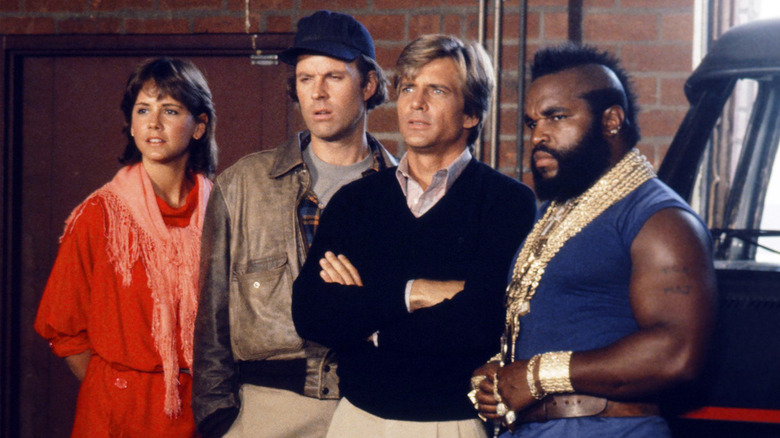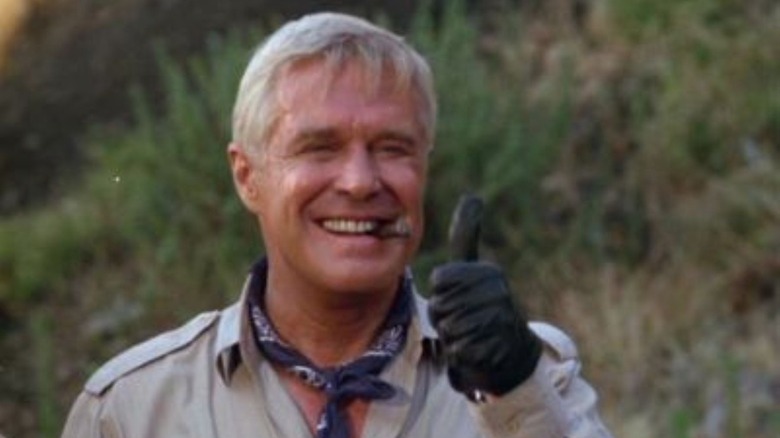Why NBC Suddenly Canceled The A-Team In The Middle Of A Season
America had just crawled out from under its Vietnam hangover when Stephen J. Cannell's "The A-Team" blasted its way into the country's living rooms on January 23, 1983. NBC did not have high expectations for the show, but when the second episode — which aired after Super Bowl XVII (the one where Washington's John Riggins rushed with shocking impunity against Miami's defense) — scored sky-high ratings, the network realized it had a hit on its hands.
It was the right show for a weird moment in American history. The country had gone gung-ho. We were at the advent of the '80s action hero era, and everyone was flocking to bloody, high-caliber entertainments starring the likes of Charles Bronson, Chuck Norris, and Sylvester Stallone. Meanwhile, the pulpy adventures of Don Pendleton's Mack Bolan were flying off drug store bookshelves. There was an acute interest in vigilante justice, but people were also looking to exorcise the demons of a failed conflict. "The A-Team" hooked viewers with the premise of an Army unit that, as we were told at the outset of every episode, was convicted of a crime they didn't commit. Essentially, they were being hunted by a country that did them dirty in a war no rational person wanted to fight, so we cheered them on as they rambled from town to town and helped the powerless fight back against their local oppressors.
We enjoyed the familiar, occasionally contentious interplay between the savvy Lieutenant Hannibal Smith (George Peppard), Lieutenant "Faceman" Peck (Dirk Benedict), Sergeant B.A. Baracus (Mr. T), and pilot H.M. "Howling Mad" Murdock (Dwight Schultz). And, perhaps most importantly for the era, we loved their use of various firearms.
The show was a smash, but when America's interests shifted, it died quickly. How did this happen?
Bloodlessness in the time of Rambo
"The A-Team" was a top-ten Nielsen ratings show over its first three seasons. It was as popular as "Monday Night Football," and owned the Tuesday night 8 p.m. slot. That was family hour on primetime television, which meant "The A-Team" had to essentially function as a live-action cartoon. Cannell and his writers could employ all the high-tech weaponry they wanted, and blow up all manner of vehicles, but they couldn't kill anyone.
It's probably not a coincidence that the series' sudden ratings decline in 1985 (when it plummeted from sixth to 30th) came after the massive box office success of Sylvester Stallone's "Rambo: First Blood Part II." That movie's massive body count and wanton gore heightened America's bloodlust. The gunplay wasn't enough; they wanted to see the bad guys get shredded by Uzis and M60s.
Broadcast standards prohibited "The A-Team" from providing such vicious spectacle, so viewers abruptly checked out. When the series moved to Friday at 8 p.m. and nosedived to 61st in the Nielsen ratings, NBC quickly pulled the plug two episodes before it reached the magic 100 threshold (which guarantees syndication). As a result, the show vanished from popular culture, becoming a nostalgia item instead of an enduring TV classic.
Even if "The A-Team" had passed the 100-episode mark, it was too silly and dated to be a timelessly entertaining rerun machine like "The Rockford Files" or the original "Star Trek." But it served its purpose, and remains a cherished Gen X relic to this day.

